Ancient Indian Masters
Nagarjuna:
 One of the six great commentators (the “Six Ornaments”) on the Buddha’s teachings, the great scholar Nagarjuna is revered as an unsurpassed master by all Buddhist schools. His teachings provide the foundation for the Madhyamika School, which propounds the “Middle Way” philosophy, accepted as the highest view within the sutrayana. He was also the revealer of the Prajnaparamita Sutras, the core teaching of the second turning of the wheel of the Dharma. He is counted among the eighty-four mahasiddhas, and among the eight vidyadharas. Nagarjuna
One of the six great commentators (the “Six Ornaments”) on the Buddha’s teachings, the great scholar Nagarjuna is revered as an unsurpassed master by all Buddhist schools. His teachings provide the foundation for the Madhyamika School, which propounds the “Middle Way” philosophy, accepted as the highest view within the sutrayana. He was also the revealer of the Prajnaparamita Sutras, the core teaching of the second turning of the wheel of the Dharma. He is counted among the eighty-four mahasiddhas, and among the eight vidyadharas. Nagarjuna
Most important works:
-
-
-
-
-
-
- Root Verses on the Middle Way (Skt. Mulamadhyamakakarika),
- In Praise of Dharmadhatu (Skt. Dharmadhatustava),
- Letter to a Friend (Skt. Suhrllekha),
- Nagarjuna’s Precious Garland (Skt. Ratnavali).
-
-
-
-
-
Aryadeva
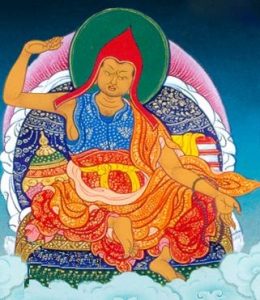 One of the six great commentators (the “Six Ornaments”) on the Buddha’s teachings. Aryadeva was a disciple of Nagarjuna and devoted his life to continuing his master’s work, consolidating the Madhyamika tradition. He is also counted among the eighty-four mahasiddhas.
One of the six great commentators (the “Six Ornaments”) on the Buddha’s teachings. Aryadeva was a disciple of Nagarjuna and devoted his life to continuing his master’s work, consolidating the Madhyamika tradition. He is also counted among the eighty-four mahasiddhas.
Most important works:
- Aryadeva’s Four Hundred Stanzas on the Middle Way (Skt. Catuhsataka shastra nama Karika)
Asanga
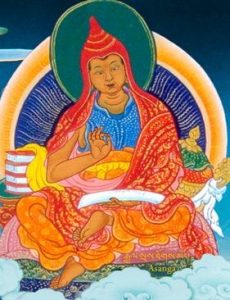 One of the most famous Indian saints, he lived in the fourth century and was the elder brother of Vasubandhu. He received teachings from Maitreya and transcribed them as the “Five Treatises of Maitreya.” Together with Asanga’s own commentaries, these texts became the basis for the philosophical school known as Yogachara, or Chittamatra.
One of the most famous Indian saints, he lived in the fourth century and was the elder brother of Vasubandhu. He received teachings from Maitreya and transcribed them as the “Five Treatises of Maitreya.” Together with Asanga’s own commentaries, these texts became the basis for the philosophical school known as Yogachara, or Chittamatra.
Most important works:
-
-
-
-
-
-
- Five Treatises of Maitreya: Ornament of Clear Realization (Skt. Abhisamayālamkāra),
- Ornament of the Mahayana Sutras (Skt. Sutrālamkāra),
- The Distinction Between Middle and Extremes (Skt. Madhyanta Vibhāga),
- The Distinction Between Phenomena and Their Nature (Skt. Dharma Dharmatā Vibhāga),
- The Ultimate Continuum of the Mahayana (Skt. Uttaratantra Shāstra)
-
-
-
-
-
Vasubandhu
 He was the younger brother of Asanga, and composed The Treasury of Abhidharma (Skt. Abhidharmakosha), a complete and systematic account of the Abhidharma, the peak of scholarship in the Fundamental Vehicle. Later he followed the Mahayana Yogachara view, and wrote many works, such as Thirty Stanzas on the Mind (Skt. Trimsikavijnapti Karika)
He was the younger brother of Asanga, and composed The Treasury of Abhidharma (Skt. Abhidharmakosha), a complete and systematic account of the Abhidharma, the peak of scholarship in the Fundamental Vehicle. Later he followed the Mahayana Yogachara view, and wrote many works, such as Thirty Stanzas on the Mind (Skt. Trimsikavijnapti Karika)
Most important works (among many):
- Treasury of Abhidharma (Skt. Abhidharmakosha),
- Treatise on the Three Natures (Skt. Trisvabhāvanirdesa).
Dignāga
 He was one of the four great disciples of Vasubandhu, each of whom surpassed their teacher in a particular field. Dignāga was more learned than Vasubandhu in pramāna (epistemology). His unequaled reputation in debate was cemented through his celebrated victory over the brahmin named Sudurjaya at Nalanda monastery. Among his disciples was Ishvarasena, who later became the teacher of Dharmakirti.
He was one of the four great disciples of Vasubandhu, each of whom surpassed their teacher in a particular field. Dignāga was more learned than Vasubandhu in pramāna (epistemology). His unequaled reputation in debate was cemented through his celebrated victory over the brahmin named Sudurjaya at Nalanda monastery. Among his disciples was Ishvarasena, who later became the teacher of Dharmakirti.
Most important work:
Compendium of Valid Cognition (Skt. Pramāna-samuccaya)
Bhāvaviveka
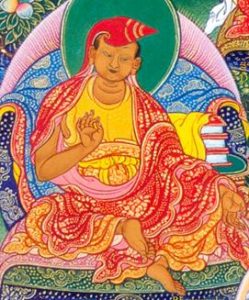 Bhāvaviveka (Skt. Bhāvaviveka; Tib. ལེགས་ལྡན་འབྱེད་, lekden jé, Wyl. legs ldan ‘byed), aka Bhāviveka (Bhāviveka; སྣང་བྲལ་, snang bral) or Bhāvya (སྐལ་ལྡན་, kalden, skal ldan) (c.500-570), was a sixth century master of the Svatantrika school of Madhyamika. He was critical of Buddhapalita’s interpretation of Nagarjuna’s classic work The Root Verses on the Wisdom of the Middle Way, because he believed Buddhapalita should have put forward independent logical arguments, rather than simply pointing out the flaws in others’ positions. The great master Chandrakirti later defended Buddhapalita’s approach and sought to refute Bhāvaviveka.
Bhāvaviveka (Skt. Bhāvaviveka; Tib. ལེགས་ལྡན་འབྱེད་, lekden jé, Wyl. legs ldan ‘byed), aka Bhāviveka (Bhāviveka; སྣང་བྲལ་, snang bral) or Bhāvya (སྐལ་ལྡན་, kalden, skal ldan) (c.500-570), was a sixth century master of the Svatantrika school of Madhyamika. He was critical of Buddhapalita’s interpretation of Nagarjuna’s classic work The Root Verses on the Wisdom of the Middle Way, because he believed Buddhapalita should have put forward independent logical arguments, rather than simply pointing out the flaws in others’ positions. The great master Chandrakirti later defended Buddhapalita’s approach and sought to refute Bhāvaviveka.
Most important works:
- Tarkajvāla (Heart of the Middle Way and its auto-commentary, Blaze of Reason); Adhyamakārtha-saṃgraha
- Prajñāpradīpa, a commentary on the Root Verses of the Wisdom of the Middle Way
- Karatalaratna (only available in Chinese)
- Madhyamaka-ratna-pradīpa
Dharmakirti

Dharmakirti was born to a brahmin family in the South of India. After receiving a Brahmanical education, he later became interested in Buddhist teachings. He then traveled to Nalanda to receive teachings from a direct disciple of Vasubandhu. Dharmapala was still living — Dharmakirti received ordination from him — but Dignaga had passed away. Instead, he received instruction from Ishvarasena, who was Dignaga’s direct disciple. Having entirely comprehended Dignaga’s oeuvre, he became perhaps the greatest master of pramāna and went on to compose the Seven Treatises on Valid Cognition.
Most important work:
Seven Treatises on Valid Cognition (Skt. Pramāna-vārtika)
Chandrakirti
Chandrakirti (Skt. Candrakīrti; Tib. zla ba grags pa ཟླ་བ་གྲགས་པ་; C. Yuèchēng 月稱) (c. 600 – c. 650) was an Indian scholar of the Madhyamaka school and a noted commentator on the works of Nagarjuna (c. 150 – c. 250 CE) and those of his main disciple, Aryadeva. His most influential works are Prasannapadā (Clear Words) and Madhyamakāvatāra.
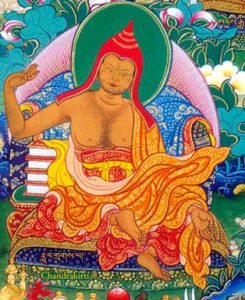
Very little is known about Chandrakirti’s life. Tibetan sources state that he was born in South India and was a student of Kamalabuddhi. He is traditionally associated with Nalanda Mahavihara where he may have been a monk.
Most important works:
- Prasannapadā (Clear Words: A Commentary on Nagarjuna’s Mūlamadhyamakakārikā)
- Madhyamakāvatāra (Entering the Middle Way)
- Catuḥśatakaṭīkā (Commentary on the 400: A Commentary on the 400 Verses of Aryadeva)
- Yuktiṣaṣṭikāvṛtti (Commentary on the Sixty Stanzas on Reasoning)
- Shūnyatāsaptativṛtti (Commentary on the Seventy Stanzas on Emptiness)
- Triśaraṇasaptati (Seventy Verses on Taking Refuge)
https://encyclopediaofbuddhism.org
Shantideva
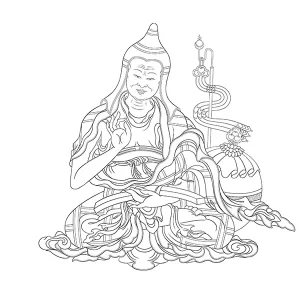 Shantideva (Skt. Śāntideva; Tib. ཞི་བ་ལྷ་, Shiwa Lha; Wyl. zhi ba lha) was a scholar in the eighth century from the monastic university Nalanda, one of the most celebrated centers of learning in ancient India. According to legend, Shantideva was greatly inspired by the celestial bodhisattva Manjushri, from whom he secretly received teachings and great insights. Yet as far as the other monks could tell, there was nothing special about Shantideva. In fact, he seemed to do nothing but eat and sleep. In an attempt to embarrass him, the monks forced Shantideva’s hand by convincing him to publicly expound on the scriptures. To the amazement of all in attendance that day, Shantideva delivered the original and moving verses of the Bodhicharyāvatāra. When he reached verse thirty-four of the ninth chapter, he began to rise into the sky, until he at last disappeared. Following this, Shantideva became a great teacher.
Shantideva (Skt. Śāntideva; Tib. ཞི་བ་ལྷ་, Shiwa Lha; Wyl. zhi ba lha) was a scholar in the eighth century from the monastic university Nalanda, one of the most celebrated centers of learning in ancient India. According to legend, Shantideva was greatly inspired by the celestial bodhisattva Manjushri, from whom he secretly received teachings and great insights. Yet as far as the other monks could tell, there was nothing special about Shantideva. In fact, he seemed to do nothing but eat and sleep. In an attempt to embarrass him, the monks forced Shantideva’s hand by convincing him to publicly expound on the scriptures. To the amazement of all in attendance that day, Shantideva delivered the original and moving verses of the Bodhicharyāvatāra. When he reached verse thirty-four of the ninth chapter, he began to rise into the sky, until he at last disappeared. Following this, Shantideva became a great teacher.
Most important works:
- The Way of the Bodhisattva (Skt. Bodhisattvacaryāvatāra)
- An Anthology of Training (Śikṣāsamuccaya)
Watch video:
Padmasambhava (Guru Rinoche)
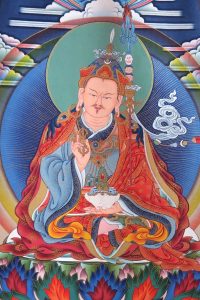 Despite the many layers of legend that have accreted around Padmasambhava, scholars generally agree that a renowned Indian tantric master by that name did visit and teach in Tibet in the late eighth century. Our earliest evidence for his activities comes from several tenth-century manuscripts found in the so-called “library cave” of Dunhuang. Pelliot tibétain 44 is a small booklet devoted to the tantric deity Vajrakīla. It describes the master’s time in India and Nepal prior to his trip to Tibet. According to this account, he gathered the texts and performed the rites for The Hundred Thousand [Verse] Tantra of Vajrakīla (phur bu’i ‘bum sde) at the Asura cave in Yanglesho (yang le shod), Nepal. During this same period, he is also said to have tamed four troublesome Se (bse) goddesses and bestowed upon them new Buddhist names. On gaining accomplishment in the practices of Vajrakīla, the master then performed a series of miracles, including the magical diversion of a stream for irrigation purposes.
Despite the many layers of legend that have accreted around Padmasambhava, scholars generally agree that a renowned Indian tantric master by that name did visit and teach in Tibet in the late eighth century. Our earliest evidence for his activities comes from several tenth-century manuscripts found in the so-called “library cave” of Dunhuang. Pelliot tibétain 44 is a small booklet devoted to the tantric deity Vajrakīla. It describes the master’s time in India and Nepal prior to his trip to Tibet. According to this account, he gathered the texts and performed the rites for The Hundred Thousand [Verse] Tantra of Vajrakīla (phur bu’i ‘bum sde) at the Asura cave in Yanglesho (yang le shod), Nepal. During this same period, he is also said to have tamed four troublesome Se (bse) goddesses and bestowed upon them new Buddhist names. On gaining accomplishment in the practices of Vajrakīla, the master then performed a series of miracles, including the magical diversion of a stream for irrigation purposes.
According to legends, Padmasambhava was born amidst miraculous circumstances and grew up a prince in Oḍḍiyāna, in northwestern India. As a youth, the prince turns to tantric practice, and before long, the local people force his father, the king, to send him into exile. Padmasambhava then travels around India, receiving teachings and practicing in sacred charnel grounds. Eventually he arrives in Yanglesho, where he gathers the texts of Vajrakīla, ends a drought by defeating some troublesome local spirits, and gains realization. While in Nepal, he receives King Tri Songdetsen’s invitation and proceeds to Tibet, where he battles a now much-expanded series of local Tibetan spirits, helps to establish Samye, and leaves while pronouncing many ominous prophecies regarding the future of Buddhism in Tibet.
Shantarakshita
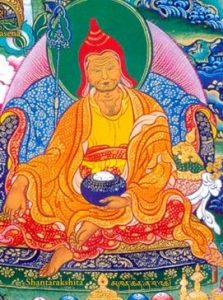 Shantarakshita (Skt. Śāntarakṣita; Tib. ཞི་བ་འཚོ་, Shyiwa Tsho, Wyl. zhi ba ‘tsho) (725–788), also called Khenpo Bodhisattva, ‘Bodhisattva Abbot’. This great Indian pandita of the Mahayana school was abbot of the Buddhist university of Nalanda. He was invited to Tibet by King Trisong Detsen where he founded the temple and monastery of Samyé and ordained the first seven Tibetan monks, thus establishing the Tibetan Sangha, according to Nagarjuna’s Sarvastivadin tradition. He worked extensively to uphold and maintain the Buddhist teachings, and so began to establish the Buddhadharma in Tibet. However, indigenous forces that opposed and were hostile to the Dharma were increasing in strength. Neither the might of the king, Trisong Detsen, nor the power of the great abbot Shantarakshita could subdue them, and so they invited Guru Rinpoche to come to Tibet.
Shantarakshita (Skt. Śāntarakṣita; Tib. ཞི་བ་འཚོ་, Shyiwa Tsho, Wyl. zhi ba ‘tsho) (725–788), also called Khenpo Bodhisattva, ‘Bodhisattva Abbot’. This great Indian pandita of the Mahayana school was abbot of the Buddhist university of Nalanda. He was invited to Tibet by King Trisong Detsen where he founded the temple and monastery of Samyé and ordained the first seven Tibetan monks, thus establishing the Tibetan Sangha, according to Nagarjuna’s Sarvastivadin tradition. He worked extensively to uphold and maintain the Buddhist teachings, and so began to establish the Buddhadharma in Tibet. However, indigenous forces that opposed and were hostile to the Dharma were increasing in strength. Neither the might of the king, Trisong Detsen, nor the power of the great abbot Shantarakshita could subdue them, and so they invited Guru Rinpoche to come to Tibet.
Most important works:
- Madhyamakālaṃkāra (Synthesis of Madhyamaka, Yogācāra, and Pramāṇa)
- Tattvasamgraha (Compendium on Reality)
Tilopa
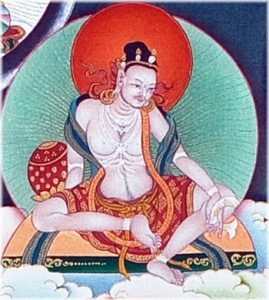 Tilopa also known as Tillipa, Telopa or Tailopa (Tib. ཏི་ལོ་པ་) (988-1069) — the most important source of the Kagyü lineage is traced back to the great Indian yogi Tilopa and one of his main disciples, Naropa (1016-1110). He is also counted among the eighty-four mahasiddhas.
Tilopa also known as Tillipa, Telopa or Tailopa (Tib. ཏི་ལོ་པ་) (988-1069) — the most important source of the Kagyü lineage is traced back to the great Indian yogi Tilopa and one of his main disciples, Naropa (1016-1110). He is also counted among the eighty-four mahasiddhas.
Naropa
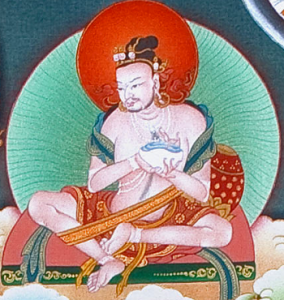 Nāropa (Tib. ནཱ་རོ་པ་) or Nadapada or Abhayakirti (956-1040) was an important master in the Kagyü tradition. He was a disciple of the mahasiddha Tilopa and a teacher of Marpa the translator and many others. He is also counted among the eighty-four mahasiddhas.
Nāropa (Tib. ནཱ་རོ་པ་) or Nadapada or Abhayakirti (956-1040) was an important master in the Kagyü tradition. He was a disciple of the mahasiddha Tilopa and a teacher of Marpa the translator and many others. He is also counted among the eighty-four mahasiddhas.
Atiśa Dīpaṃkara
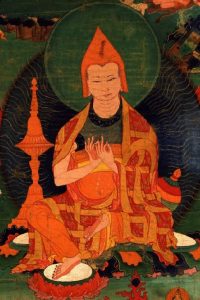
The Bengali monk Atiśa Dīpaṃkara was of pivotal importance in the second transmission of Buddhism in Tibet. Invited from the Indian monastery-university of Vikramaśila to Tibet by the Purang kings, Atiśa spent thirteen years in Ngari and U-Tsang. He is credited with the propagation of the Lamrim and Lojong teachings that later became the core of the Geluk tradition; his composition, the Bodhipathapradīpa is a central text for the Lamrim, or Stages of the Path. He was also instrumental in the spread of the cult of Tārā in Tibet. Atiśa’s disciple Dromton founded several important monasteries and gave rise to the Kadam tradition, which was later absorbed by the Geluk and, to some extent, the Sakya and Kagyu traditions.
Most important works:
- Bodhipathapradīpa
- Bodhipathapradipa-panjikanama
- Charyasamgraha-pradipa (contains some kirtan verses composed by Atiśa)
- Prajnaparamita-pindartha-pradipa
Facebook Comments